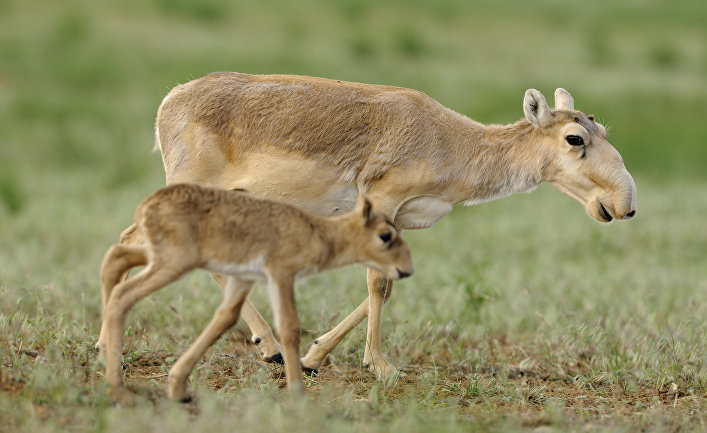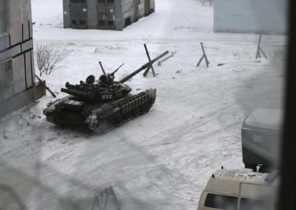
In the remote steppes of Central Kazakhstan in may 2015 has been a truly extraordinary and tragic event. Female saiga gathered in huge quantities on the open plain below in a short 10-day period to produce offspring. Arrived there to shoot the operators of Bi-Bi-si and a team of researchers witnessed how hundreds of thousands of saiga antelopes died within just a couple of weeks. This tragedy managed to capture on camera and to show in the latest episode of the documentary film bi-Bi-si “Earth II”.
But why was this mass death of animals? Knocking in huge herds in a very short time, the saigas are a huge living mass, and the probability of death of calves as a result of the attacks, their main enemy is the wolf from it decreases. Young saigas are born from large and well-developed. The weight of newborn calf in the ratio of the largest wild ungulates, and after a few days he was able to escape from a predator. To produce offspring in the shortest time possible you also need to ensure that the cubs had to eat plenty of juicy spring grass, which withers and dries up from the heat coming in these harsh continental steppe in the summer.
In 1994 another team of bi-Bi-si he directed his first film about the nature of the former Soviet Union. It is possible to see huge herds of saiga.
But since then much has changed. In the early 2000-ies almost all saigas were wiped out by poachers who hunted them for their horns and meat. In this regard, in 2001 saigas brought in the Red book of the International Union for the conservation of nature and natural resources.
By 2015, the governments, scientists and nonprofit organizations are beginning to bear fruit. If at the beginning of the 2000s, numbers have reduced to a minimum, amounting to 50 thousand animals, at the beginning of 2015, there have been about 300 thousand. Basically the large increase in livestock occurred due to one population of Central Kazakhstan. It is there in 2015, went on shooting the episode “Earth II” operators Bi-Bi-si, to capture footage of calving.
Mass death
They were accompanied by a group of researchers collected the Kazakhstan Association of biodiversity, which also included scientists from the Royal veterinary College, decided to conduct observations of calving, to learn more about the status of the saiga population.
But the saigas have to pay for its strategy of mass delivery in a short time and in a confined space. During this period, females experience high physiological stress, which leads to higher morbidity and mortality in childbirth. In addition, sometimes the weather surprises, and the calves often die from hypothermia. Most often, everything goes well, but history is replete with examples of death from disease in the calving season. I must say that the researchers from the Royal veterinary College came to observe the calves just for the reason that a few years earlier in the calving areas of other populations was observed mass mortality.
But the crew was absolutely not prepared for what happened in 2015 right before her eyes. Stumbling in herds to give birth, antelope weakened movement they became more and more uncoordinated, and they died in a few hours. Very soon, the corpses of antelopes were dotted with a vast territory, stretching for hundreds of kilometers. After the females began to die young. Had the impression that a few days in herds with ten thousandth of the population killed all the calves.
This mass death was a terrible tragedy. The world began the search for answers to the mystery of nature. Sometimes the explanation was completely ridiculous and weird in social networks several times even mentioned aliens.
We, as researchers saiga, suffered from a dichotomy of feelings. On the one hand, we have despair because of the death of the animals we studied and cared about. But on the other hand, we have the curiosity and the desire to unravel this amazing scientific mystery. The mechanism that could destroy a huge herd of saiga antelope in such a short time? Usually infectious disease begin and spread differently; the disease process of a population is a slow process, and furthermore, in the interests of the parasite to destroy the entire population on which they feed.
Maybe the point here is not infections, and some poisonous substance from the environment or weather anomalies? But what environmental factor can almost simultaneously to kill such a large number of animals in the vast area of 168 thousand square kilometers greater than the territory of England and Wales? As for the weather and vegetation, it is here at this time of the year is constantly changing.
Thanks to a grant from the British government Fund NERC Urgency and generous donations from charitable organizations for the protection of the environment and people from all over the world we very quickly formed a multinational interdisciplinary team to study the disease and its causes.
This team was headed by Richard Kok from the Royal veterinary College, and was composed of colleagues from the Kazakhstan state research Institute of biological safety problems, Kazakhstan Association of biodiversity conservation, Oxford and Bristol universities, the Food and agriculture organization of the United Nations and other institutions. We had a group of ecologists, specialists in pasture lands, veterinarians and experts on the creation of spatial models. We sent one group to the place to collect soil samples, and the dying remains of the saiga in a week after the start of the case.
Looking for answers
On the one hand, we found a clue. The immediate cause of death was the toxic effects of bacteria normally found in the respiratory tract of animals. It’s called Pasteurella multocida. But then arose the next question: why this normally harmless bacterium became such a contagious and deadly? What external or internal cause, provoked the spread of infection and mortality? What was the result: a decrease in immunity saiga to these bacteria, its rapid spread, or both?
The study of these issues like a Russian doll. Removing one layer of explanation, we find ourselves in even more questions. We examined old field notes of the Institute of Zoology of Kazakhstan for 1988, when there was a similar mass death of saigas; we looked at the data from scientific studies of mass death of other species; analyzed the differences in vegetation composition for different years. After that we built several statistical models to examine changes in temperature and precipitation at different temporal and spatial framework.
We also checked out animal tissue and soil samples and vegetation in the presence of various toxins and other harmful substances, in order to understand whether there is some deeper infection. Today the collected materials and conducted research points to a combination of short-term, but influence the situation of weather changes, and physiological stress of calving, which caused a cascading effect of virulence. But we did not find any toxins in the environment or deep infection, no influence of the aliens (yet).
These events attracted enormous public interest, both in Kazakhstan and abroad. People need quick answers and they want us to find a solution to the problems that such events are never repeated.
However, it seems that we will not be able to calm them down. It is likely that in the context of climate change such events will occur more often, not less. However, we want to publicly say the following: we need strong and numerous populations of saiga antelope, which must be securely protected from poachers.
This is the kind of constantly living on the edge, vulnerable to mass mortality, but is also able to recover quickly. To survive, the saiga must exist in large quantities on open pastures. This large-scale, well-publicized disaster has opened up new opportunities for saiga researchers and conservationists, who can now demand reliable protection for their populations so that these animals could breed, showing amazing spectacle, for which a film crew of Bi-Bi-si arrived in the wild steppe. 







